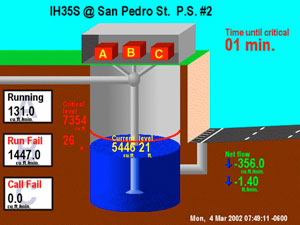Best Practices for Road Weather Management
Texas DOT Pump Station Monitoring System
The San Antonio District of the Texas Department of Transportation (TxDOT) installed monitoring systems in six storm water pump stations in locations where the roadway is below natural ground level. The pump stations are used to lift storm water to an elevation where the outflow can enter the gravity flow storm drainage system. The Monitoring Systems are used to determine the status of the pumps, determine the level of water in the wet wells, and provide an approximate time until the location floods. Before the monitoring systems were installed, maintenance crews had to visit each pump location during rain events to ascertain the status of the pumping equipment. The monitoring systems allow the maintenance crews to visit only the sites where maintenance issues and/or flood conditions require. The units were originally installed in 2000, but were recently upgraded at a cost of $13,000 each.

Figure TX-2. Storm water pump station: graphic image available to TxDOT operations and maintenance staff.
System Components: The Pump Station Monitoring system consists of equipment located in the pump stations, communications to the TransGuide Operations Center, and an Internet display of the pump station data for TxDOT maintenance and operations staff. The equipment in the system includes the following elements:
- Field Computer
- Remote terminal unit
- Analog Input Module
- Pump Station Uninterruptible Power Supply (UPS)
- Internet Protocol (IP) Network Interface
- Central/Master Software
- Internet display
System Operations: The Pump Station Remote Terminal Units (PRTU) are connected to the sonic detector installed at the top of the wet well, which is used to determine the level of the water in the wet well. The sonic detector is connected to the pumps, and activates the pumps based on the water level. The PRTUs are connected to the pumps using contact closures, and determine when the pumps are in operation. The PRTUs transmit data from the pump stations to the TransGuide Operations Center. The pump station data is processed by the central software, and is available to TxDOT operations and maintenance staff using a non-public Internet display. The maintenance staff operations staff can dispatch technicians to repair failed pumps, or dispatch crews to set barricades if flooding of the roadway is imminent. Operations staff can place warning messages on Dynamic Message Signs, notify TxDOT public information staff and the media of flood conditions, and notify emergency services when flood conditions are present.
Transportation Outcome(s): The San Antonio pump stations monitoring systems allow TransGuide operators to monitor pump operations during a storm incident and inform the public and response agencies should the pumps not be able to keep up with demand. It allows maintenance crews to monitor the pump stations equipment, dispatch repair technicians, and dispatch crews to set barricades when flood conditions are imminent.
Implementation Issues: Implementation of the pump station monitoring systems required that equipment from several manufacturers be interconnected. TxDOT was not aware of any prior applications where this equipment was used in this manner. The sonic detector had a standard data output port which was used as the basis of the system. Using the data output port, the detector provided the elevation of the water in the wet well. A remote terminal unit was identified that allowed for multiple contact closure connections (required for the pump status), in addition to receiving the elevation data from the sonic sensor. A software application was developed that included the central software and the software required for the computer in the remote terminal unit. The physical characteristics of the pump stations varied (engines, wet well diameter & height), and had to be researched for each pump station. The elevation of water in the wet well that would result in flooding of the roadway was initially estimated, and updated based on observed conditions following activation of the systems.
Contact(s):
- Brian G. Fariello, P.E., TxDOT-TransGuide, Traffic Management Engineer, 210-731-5247.
Reference(s):
Keywords: TxDOT, TransGuide, Storm, Water, Pump, Station, Detection.
previous | next